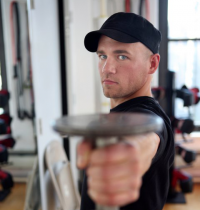World’s Greatest Warm-Up


By Rob Sulaver
How we prepare for a workout is vital. It’s the pre-battle ceremony…the ritual of warm-up….the commencement of ass-kick.
Excellent exercise prep gives our body AND mind the opportunity to fully embrace the shit-storm that is about to commence. It also maximizes our results. Our warm-up is as much a part of our development as our training block. It will help improve our tissue quality, mobility, posture, strength, AND durability. That’s a lot of winning in 7-9 minutes.
The World’s Greatest Warm-Up is comprised of three main categories:
1. Myofacial Release(i.e. foam rolling)
2. Dynamic Stretching
3. Neutral activation
Let’s divide and conquer.
Myofacial Release
The funny thing about tension is that it has a way of continually reasserted itself...even when we’re sure it’s been abolished. Soft tissue work therefore is not a one-and-done kinda relationship. Think long term - we need to address our tissue quality on a continuousbasis. That means the firstthing we should do when you get to the gym is foam roll.
Intuitively we know what trigger points are. Rub your traps and you’ll feel areas of excess pain. These are trigger points - the physical manifestation of stress in the body.
What’s going on here, on a physiological level?
Quite literally, our muscles are knotted up. Actually, that’s a lie. There are no literal “knots”. Trigger points are small patches of tightly contracted muscles - an isolated spasm (not a whole-muscle spasm, like a cramp - just a tiny one.) This isolated spasm causes issues with circulation which, of course, makes the problem even worse.
Remember that our muscles are made up of spindles all bundled together, like steal cables. In order for muscles to work well, they have to slide. Knots, as you might imagine, are the enemy of slidage. Ergo, trigger points prevent muscles from working optimally. WeCANNOT operate at fullpotential if wedo not address our tissue quality.
Trigger points are also painful (sometimes extremely so):
▪ Active trigger points actively refer pain. They hurt. Always.
▪ Latent trigger points don’t refer pain when you’re just chilling, but will do so when pressure or strain is applied to the area.
Who wants pain? Wedon't need that in our lives. We have to physically get in there and break up these fibrous adhesions. I love the analogy of the knot in the rubber band: stretch a rubber band with a knot in the middleand the knot just gets tighter. But go in there and remove the knot and the rubber band is longer and more elastic. That’s what this is all about.
There are numerous tools to helpattacktrigger points: foam rollers, tiger tails, baseballs, lacrosse balls, golf balls, barbells, and massage therapy. Each have unique benefits. Foam rolling is an excellent place to start because it’s simple, affordable, accessible, and can be done on a daily basis. Seek and destroy these trigger points with this foam rolling routine:
Wall Slides
After a few minutes on the foam roller, let’s quickly address our thoracic imbalance. Because we spend so much time in flexion and internal rotation (you’re probably there RIGHT NOW), we need to counterbalance this with extension and external rotation. 10 wall slides before every workout will put our shoulders through full-range & have a profound impact on our posture:
Boom. We’re rocking. We’re rolling. Let’s get mobile.
Stretching 101 tells us that static stretching will inhibit neural drive and dynamic stretching will activate it. The science: when we stretch and hold a muscle at end range, after 7-10 seconds we activate the Golgi Tendon Organ (GTO). As you may have gathered, this is an organ, located in tendons, named after an Italian physician - Camillo Golgi. This magical injury-prevention mechanism says, "rut roh, there's a lot of tensions going on here" and automatically "shuts off" the muscle by inhibiting muscle spindle activity. Yea. Pretty awesome. So generally speaking, we want our warm-up to tend towards dynamic stretches and our cool-down to tend towards static stretches (no need to “shut off” a muscle before a workout.) In other words, we should stretch with movement before we workout, stretch and hold after we workout. THAT SAID, common sense prevails. If we're new to exercise, the benefits of pre-workout static stretching can out-weight the detriments.
Address thoracic mobility and a lot of the big business lower body musculature with the aptly namedWorld's Greatest Stretch. Feel free to take it slow initially, then speed things up as you become more dialed:
From there let’s move into a little core activation. Our core is pivotal in so much of what we do in the weight room. Let's make sure it's alive:
Hell yea. We’re flying at this point. Last part of the warm up we head into the weight room and get after some movement-specific neutral activation. The idea is to lubricate the movement pattern and systematicallywork up to our prescribedintensity.
This is the part of the warm-up that is based very specifically on the workout. If we’re going for a run, doing some leg swings / marching / skipping would be a good idea. If we’re going to lift, doing a few sets of our first training block would be a good idea.
Our set and rep scheme will effect the specifics, but a basic template mightbe:
▪ 5 reps @ 50% of working weight
▪ 3 reps @ 75% of working weight
▪ 2 reps @ 85% of working weight
▪ 1 rep @ 90% of working weight
The idea is NOT to be fatigued going into the first set, but to be physiologically and neurologically AMPED. Some folksfeel better with a slightly shorter exercise specific warm-up. I happen to feel better with a slightly longer exercise specific warm-up (hey…I’m getting old.) To thy own self be true.
This is the point at which I que up Eminem:
We’re gonna rock this house until we knock it down so turn the volume loud.
Pony up, cowboy. You’ve never been more ready to get yolked.
Looking for a kick ass workout at this point? The Greatest Weight-loss Exercise in the History of Gravity: http://owl.li/ytRYb
HOW DO YOU GET READY TO LIFT?
FOR THE LOVE OF STRENGTH, PLEASE DON'T TELL ME, "I RUN ON THE TREADMILL.”
ABOUT THE AUTHOR

Writer, trainer, coach, sports nutritionist and fitness ninja rockstar Rob Sulaver owns and operates Bandana Training. He dishes out fitness, nutrition, and lifestyle advice with a dash of awesomesauce and glass of ass-kick juice. Rob enjoys strong things like tanks, front squats, and fast twitch muscle fibers. He also loves to cuddle.
Website: http://www.bandanatraining.com/
Facebook: https://www.facebook.com/BANDANATRAINING
Twitter: https://twitter.com/bandanatraining
